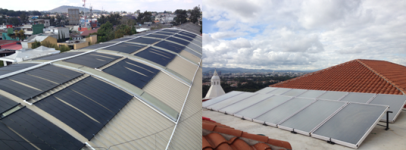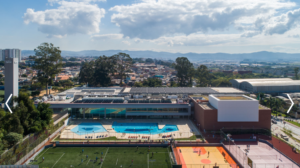Guatemala: Growth without Subsidies
June 26, 2014
 Despite the total lack of public incentives, the Guatemalan solar thermal market is growing at a steady rate. High electricity prices combined with a welcoming climate and market environment are turning solar thermal into an increasingly attractive technology. One of the country’s main solar thermal installers, Enersol, has been around for almost 30 years and installs both unglazed collector fields for swimming pools (left) and hot water systems for hotels and residential users (right).
Despite the total lack of public incentives, the Guatemalan solar thermal market is growing at a steady rate. High electricity prices combined with a welcoming climate and market environment are turning solar thermal into an increasingly attractive technology. One of the country’s main solar thermal installers, Enersol, has been around for almost 30 years and installs both unglazed collector fields for swimming pools (left) and hot water systems for hotels and residential users (right).Photos: Enersol
Guatemala is one of the Latin American economies most dependent on fossil fuels. The 12.7 million inhabitants of the fairly small country to the south of Mexico covered 35 % of their primary energy consumption through imported oil sub-products (diesel etc.) in 2012, while 57 % was covered by firewood, and only around 6 % of the total energy consumption was generated by renewable energy sources, such as hydro, geothermal or solar power, according to information from the national Ministry of Energy and Mines (MEM).
The consequences of the country’s dependence are obvious: With oil prices above USD 100 per barrel, electricity generation costs and end consumer prices are among the highest across the continent. According to CNEE (Comisión Nacional de Energía Eléctrica Guatemala), residential customers pay around 0.28 USD/kWh and commercial consumers pay only slightly less (0.24 USD/kWh).
World Gym saves up to 80 % of the energy demand for hot water
In this situation, technologies such as solar thermal are being pushed to the forefront. According to Max Lainfiesta, Founder and Managing Director of Enersol, a solar thermal and PV installer founded in 1986, the market is growing at a steady rate. “We estimate a 10 % yearly growth, mostly with residential and commercial customers, such as hotels or gyms.” In fact, Enersol has recently installed 315 unglazed collectors at the World Gym Cayalá in Guatemala City. Thanks to the new installation, the gym is saving up to 80 % of the energy demand for hot water. Enersol imports its collectors from Israel and Brazil.
Lainfiesta sees the technology’s increasing market penetration as mainly driven by economic factors. “The investment in one residential or commercial system is paid back in 1.5 to 2.5 years. Industrial consumers have a payback period of 4 to 5 years, since they have lower tariffs. High electricity prices are making it easier for us to sell solar technologies to a wide range of clients,” Lainfiesta believes.
New association to promote solar technology
The growth of the Guatemalan market is even more significant considering that there is not one single public incentive for the technology. “What’s more, we find some counter-incentives, such as a 10 % import duty on thermal collectors,” Lainfiesta complains. The head of Enersol explains that some companies are currently planning to establish a new solar association. “The idea of the organisation is to promote the technology while calling for incentives from the current government,” Lainfiesta says.
Last year, Enersol installed some 1,400 solar thermal heaters totalling 5,260 m² in Guatemala. According to the company head, Enersol has a 20 % share in the country’s thermal market. There are no publicly available figures on installed capacity, but Enersol has estimated market volume to have been around 26,000 m² in 2013.
According to Lainfiesta, most of the collectors sold across Guatemala come from four key countries: China (33 %), Israel (33 %), Mexico (15 %) and Costa Rica (15 %). Around 60 to 70 % of the heating systems are made of polypropylene plastic and they are mostly used for pools and water heating during industrial processes. So far, Guatemala has not had any local solar thermal collector manufacturers.


